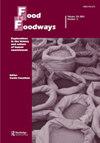吃你的茶:发酵茶叶沙拉的意外和未完成的跨文化历史(laphet thoke)
IF 1.1
Q2 ANTHROPOLOGY
引用次数: 1
摘要
摘要:“谁能想到,在我们菜单上的所有菜肴中,美国人会疯狂地选择一种混合了黑色美味的发酵茶酱的沙拉?”对缅甸超级明星的laphet thoke(发酵茶叶沙拉)的需求最初令旧金山餐馆老板Desmond Tan感到惊讶。到2018年,这家餐厅的发酵茶叶沙拉在Yelp上成为美国第四大最受欢迎的餐厅菜品。这道菜的新星与殖民时代对其主要原料laphet(发酵茶)的描述大相径庭,后者被描述为“一团腐烂的碎叶子”。目睹了缅甸超级明星(Burma Superstar)的煎饼火的成功,以及2012年缅甸民主改革后人们对缅甸菜的兴趣日益浓厚,一大批美国餐馆推出了各种版本的煎饼火,数十位美食作家很快就发布了煎饼火的食谱。尽管沙拉最近受到追捧,但laphet对厨师和家庭厨师来说仍然很少见。这篇文章的重点是笔记本thoke,并认为它的起源、材料特性和烹饪创新促成了它在美国美食家中的流行。通过谭对沙拉及其关键食材的改造,这件作品揭示了一些外来食物被改造并成为时尚美食的过程。本文章由计算机程序翻译,如有差异,请以英文原文为准。
Eat Your TeaTM: the unexpected and unfinished intercultural history of fermented tea leaf salad (laphet thoke)
Abstract “Who would have thought that out of all the dishes on our menu, Americans would go nuts for a salad mixed with a dark savory paste of fermented tea?” The demand for Burma Superstar’s laphet thoke (fermented tea leaf salad) came initially as a surprise to San Francisco-restaurateur Desmond Tan. By 2018 the restaurant’s fermented tea leaf salad was the fourth most popular restaurant item in the country on Yelp. The dish’s nascent stardom is a dramatic departure from a colonial-era description of its key ingredient, laphet (fermented tea), as a “putrescent mass of smashed up leaves.” Witnessing the success of Burma Superstar’s laphet thoke, and a crescendo of interest in Burmese cuisine following Myanmar’s democratic reforms in 2012, an array of American restaurants has offered various versions of it, and dozens of food writers have been quick to publish recipes for it. In spite of the salad’s new-found cult following, laphet has remained rare for chefs and home cooks. This article focuses on laphet thoke, and argues that its origins, material properties, and culinary innovations have contributed to its popularity among American foodies. And, through the example of Tan’s adaptations of the salad and its key ingredient, this piece reveals the processes by which some exotic foods are modified and materialize as trendy fare.
求助全文
通过发布文献求助,成功后即可免费获取论文全文。
去求助
来源期刊

Food and Foodways
ANTHROPOLOGY-
CiteScore
2.20
自引率
0.00%
发文量
16
期刊介绍:
Food and Foodways is a refereed, interdisciplinary, and international journal devoted to publishing original scholarly articles on the history and culture of human nourishment. By reflecting on the role food plays in human relations, this unique journal explores the powerful but often subtle ways in which food has shaped, and shapes, our lives socially, economically, politically, mentally, nutritionally, and morally. Because food is a pervasive social phenomenon, it cannot be approached by any one discipline. We encourage articles that engage dialogue, debate, and exchange across disciplines.
 求助内容:
求助内容: 应助结果提醒方式:
应助结果提醒方式:


